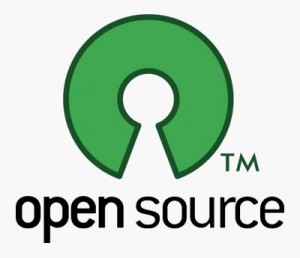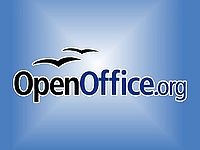Course:ETEC522/2010ST1/OpenSourceTechnologies/Leading learning applications
Leading Learning Applications:
This vector was created by Paul Quinlan
What is Open Source Software

As stated in the introduction, Open Source Software (OSS) refers to a program in which the source code is available to the general public for use and/or modification from its original design free of charge, therefore is "OPEN". The beauty of this situation is that the base code is open to developer "eyes" from around the globe and quite often bugs are found and fixed quickly. Ultimately, the benefit is to the end user, as updates are re-posted and available quicker than most closed commercial programs.
The Birth of Free Software
Richard M. Stallman (RMS), was working at MIT’s artificial intelligence lab in the early 1980s. His lab purchased a new printer from Xerox, and Stallman was having a few problems with it. If it was the older printer Richard would have been able to fix the driver code, however the new Xerox printer didn’t come with source code and that got Stallman to thinking...and thinking...
Stallman thought to create the Free Software Foundation (FSF), an organization dedicated to producing software that granted users four basic freedoms:"
1. The freedom to run the program, for any purpose. 2. The freedom to study how the program works, and adapt it to your needs. 3. The freedom to redistribute copies so you can help your neighbor. 4. The freedom to improve the program, and release your improvements to the public, so that the whole community benefits.
this article also goes on to explain these freedoms and then compare the difference b/w free and open ~ a good read and valuable source. Note: he didn't use the word Free, as in $$, but free as in freedom (to see the inner workings).
from http://www.informit.com/articles/article.aspx?p=706208
The Cathedral and the Bazaar
A great concept explanation was written by Eric S. Raymond on software engineering methods, where he compares two methods of open software development and labels them:
- the Cathedral method --in which source code is available with each software release, but code developed between releases is restricted to an exclusive group of software developers. Thus fewer people work on the development and have to work harder.
- the Bazaar method --in which the code is developed over the Internet in view of the public. (Raymond credits Linus Torvalds, leader of the Linux kernel project, as the inventor of this process)
The interesting thing about his essay is how he effectively outlines that "given enough eyeballs, all bugs are shallow" and thus the Bazaar model reigns supreme. Wherein the more open a product the more quickly bugs in programming will be discovered and thus, corrected.
The Cathedral and the Bazaar-- a great read on the premise of OSS development

SourceForge.net?

Sourceforge is an open software mega-site. It is the world's largest open source software development web site with over 230,000 software projects registered for services development and more than 2 million registered users. Here is a great online resource for finding your own downloads of available open software.
In other words....There's an App for that!
See the tutorial of Sourceforge how to find your app if you need:
SourceForge.net is owned and operated by Geeknet, Inc., a publicly traded US-based company.
Application Examples
There are literally thousands of Open learning applications available. Some of the most popular apps might include Firefox, Gimp, Audacity, VLC media player. Below I have taken a look at two in particular that are of interest, to help build towards digital inclusion.
OpenOffice.org
OpenOffice.org

OpenOffice.org version 3, also known as OOo,has constantly been developing and evolving over the past 10 years, OpenOffice.org originated as StarOffice and was released as free-ware in 1999. It is now a software suite similar to the Microsoft Office suite. OOo includes word processing (Writer), spreadsheet (Calc), presentation (Impress), graphics (Draw) and database (Base)software. It is highly adaptable in file conversion, both open and save, and runs on Windows, MacIntosh and even comes installed in most Linux based systems.
Openoffice is a phenomenal software for the price: Free. It provides teachers and students with powerful tools that they can essentially take home – no user fees or licensing makes this product an ideal software package for any student in any income bracket (digital inclusion).
Below are two short clips on OpenOffice.org
the first highlights the ease of use and the second highlights its adaptability into different platforms
While not as pretty and full of all the bells and whistles of MS Office, OpenOffice.org delivers all the power and ease of a full price office suite, again, without the price. Microsoft Office does tend to have a fancier interface/toolbar, and some higher end features, but really there is very little OOo can't do!
For this reason I give OpenOffice.org version 3 an "A-" Rating.
The price tag on this little baby definitely is an "A+"
A more detailed comparison of OOo and MS Office is available at: http://www.idealware.org/articles/msoffice_vs_openoffice.php
KOHA
KOHA

For anyone who works in a library, purchasing software to manage the large volumes of materials and the user circulation, is expensive; especially, if you would like to purchase more resources in the future. Licence fees, upgrades, customization and support are very expensive
KOHA is an integrated library system (ILS) with all the full features of an expensive library management system but none of the steep overhead costs for purchase and service(Breeding, 2002). KHOA is password protected at various levels and can handle a few, to thousands of user accounts and it is fully compliant to global library standards, and not to mention: customizable (open).
The KOHA Software can be run on a local network or a central server allowing for flexibility to use on a secured network intranet, or the web-based internet and for global access. As an emerging market application, KOHA is able to be run in wired countries around the globe via the internet and also in isolated locations on low resource client machines capable of running a web browser and accessing a server. This is great for access to a market where hardware resources are poor and may have even poorer access(Breeding, 2002).
One critisim is that often support is needed to initially customize, install, and support/train new users and IT staff. Once trained, KOHA is very user friendly, but the initial set-up and install is often recommended to be done by professionals (Poynder, 2001).
Ultimately, web-based KOHA is a great tool to help put dollars back into libraries.
Ease of installation B
Ease of Use A+
Cost A++
Overall rating A+
Other Leading Apps -- Your V1 Rocket Assignment
Feel free to rate its ease of use and how it might, or might not, be a hidden gem for us all to explore and implement.
If you are stuck watch the video at the top again or hit the bricks at [Sourceforge.net]

Other Great OSS suggested links
- OpenOffice - Open source Office applications. http://www.openoffice.org/
- KOHA - Open source Library Management software. http://koha.org/
- Audacity – digital sound editor. http://audacity.sourceforge.net/
- Notepad ++ - coding program for HTML and CSS good for coding. http://notepad-plus-plus.org/
- Scratch – MIT developed for stories, games and music http://info.scratch.mit.edu/Educators
- MySQL – online database query http://www.mysql.com/downloads/
- jmol - shows 3d Chemistry models http://jmol.sourceforge.net/
- Thunderbird – very powerful email client by Mozilla http://www.mozillamessaging.com/en-US/thunderbird/
- Cyber Duck - a Mac OSX FTP client http://cyberduck.ch/
- Freemind – mind mapping software http://freemind.sourceforge.net/wiki/index.php/Main_Page
- Opera – web browser http://www.opera.com/browser/
- Google wave – online collaboration http://wave.google.com/help/wave/closed.html
- Ktouch – a typing tutor http://ktouch.sourceforge.net/download.php
- Screentoaster -- A screen captures http://www.screentoaster.com/
- Moodle -- Learning Management Software (LMS) http://moodle.org/
- Skim – Mac OS/pdf scribbler software http://sourceforge.net/projects/skim-app/
- KMPlayer – freeware, plays most every media type even inc. files, captures video/audio http://kmplayer.en.softonic.com/
- Maxima – computer Algebra System http://maxima.sourceforge.net/
- Sci Lab - 3D modelling http://www.scilab.org/
- R – statistics processing http://cran.r-project.org/
Please feel free to add to our list of applications. Please also keep in mind that we recommend checking your download source for concerns. An excellent source for clean (virus free) software is often from trusted sites (eg. sourceforge.net & download.com).
Report Card

Overall, the Open market is getting bigger and better all the time, (software that is - sorry Wall street). With more open source systems and more people developing the software, we can't help but find things that weren't there before or have been improved by someone, somewhere in our world and passed on to the community. Time to sell your stock Mr. Gates!
Newer innovative software A+ (there's an App for that!)
Ease of use B+
Ease of implementation C
Cost of implementation A++
Overall Leading Open Applications average A
References
Bonfield, Brett and Laura S. Quinn (2007). Microsoft Office vs. OpenOffice.org. Idealware: Helping Nonprofits Make Smart Software Decisions. Retrieved from http://www.idealware.org/articles/msoffice_vs_openoffice.php
Breeding, Marshall (2002, October). An Update on Open Source ILS. Information Today, V19 (9). Retrieved from http://infotoday.com/it
Chisnall, David (2007). Free Software Versus Open Source Software. InformIT. Retrieved from http://www.informit.com/articles/article.aspx?p=706208
Derringer, P. (2009) When Free Isn't Free. Technology & Learning. 29(9). 28-32.
Poynder, Richard (2001, October). The Open Source Movement: Does this software provide a viable, user-friendly alternative to proprietary solutions? Information Today, V18 ( 9). Retrieved from http://infotoday.com/it
Schweik, C.M., Fernandez, M.T., Hamel, M.P., Kashwan, P., Lewis, Q. & Stepanov, A. (2009) Reflections of an Online Geographic Information Systems Course Based On Open Source Software. Social Science Computer Review. 27(1), 118-129.
Young, J.R. (2008) Blackboard customers consider alternatives. The Chronicle of Higher Education. 55(3), A17-A18 Retrieved from http://find.galegroup.com/gtx/infomark.do&contentSet=IACDocuments&type=retrieve&tabID=T002&prodId=CPI&docId=A185228858&source=gale&srcprod=CPI&userGroupName=ubcolumbia&version=1.0
Next:

